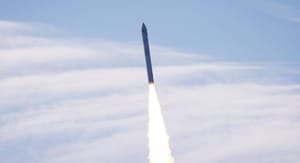
India kicked off the first launch of 2024 with the launch of a PSLV-DL rocket carrying the XPoSat spacecraft. The rocket lifted off from the Satish Dhawan Space Center at 09:10 am Indian Standard Time and successfully delivered the XPoSat spacecraft to low Earth orbit.
XPoSat, also called X-ray Polarimeter Satellite, is India's first scientific satellite dedicated to carrying out space-based polarisation measurements of X-ray emission from celestial sources according to the Indian Space Research Organisation. The satellite is carrying two payloads onboard, called POLIX and XSPECT.
The Indian Space Research Organisation states that the objectives of the XPoSat spacecraft are:
- To measure polarisation of X-rays in the energy band 8-30keV emanating from about 50 potential cosmic sources through Thomson Scattering by POLIX payload.
- To carry out long term spectral and temporal studies of cosmic X-ray sources in the energy band 0.8-15keV by XSPECT payload.
- To carry out polarisation and spectroscopic measurements of X-ray emissions from cosmic sources by POLIX and XSPECT payloads respectively in the common energy band.

POLIX is an X-ray Polarimeter for astronomical observations developed by Ramam Research Institute. The instrument is believed to contain a collimator, a scatterer, and four X-ray proportional counter detectors that surround the scatterer. It is expected to observe forty astronomical sources of interest over a five-year lifespan.
XSPECT is an X-ray SPECtroscopy and Timing payload developed by the Space
Astronomy Group of the U R Rao Satellite Centre. The payload is believed to be able to provide long-term monitoring of spectral state changes in continuum emission, changes in their line flux and profile, and simultaneous long-term temporal monitoring of soft X-ray emissions.
What is PSLV?
The Polar Satellite Launch Vehicle, commonly referred to as PSLV, is a four-stage medium-lift launch vehicle operated by the Indian Space Research Organisation. PSLV first flew on the 20th of September 1993 and was developed so India could launch its remote sensing satellites into sun-synchronous orbit but is now a leading provider of small satellite rideshare services.
PSLV is available to be launched in four versions, PSLV-CA, PSLV-DL, PSLV-QL, and PSLV-XL. In the PSLV-CA configuration, no boosters are attached to the first stage. In the PSLV-DL configuration, two boosters are attached to the first stage. In the PSLV-QL configuration, four boosters are attached to the first stage. And finally in the PSLV-XL configuration, six boosters are attached to the first stage.
The Indian Space Research Organisation claims that PSLV can send up to 3,800 kilograms to low Earth orbit or 1,750 kilograms to a sun-synchronous orbit.

PSLV can have either two, four, or six boosters attached to the first stage generating 72 tons of thrust each burning Hydroxyl-terminated polybutadiene for one-minute and ten seconds.
The first-stage is a 20 meter tall solid rocket booster generating 494 tons of thrust burning Hydroxyl-terminated polybutadiene for one-minute and fifty seconds.
The second-stage is powered by a single Vikas engine generating 82 tons of thrust for two-minutes and thirteen seconds burning Dinitrogen tetroxide and Unsymmetrical dimethylhydrazine.
The third-stage is a 3.6 meter tall solid rocket motor generating 25 tons of thrust for one-minute and fifty-three seconds burning Hydroxyl-terminated polybutadiene.
The fourth-stage is powered by two L-2-5 engines burning Monomethylhydrazine and Mixed oxides of nitrogen for up to eight-minutes and forty-five seconds generating 1.5 tons of thrust.
On the pad, the rocket is 44 meters tall with the four stages being 2.8 meters in diameter. Fully fuelled PSLV can weigh up to 320,000 kilograms.



